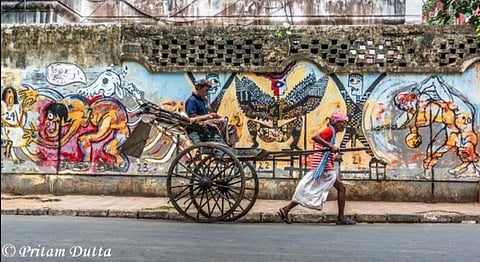
- HOMEGROWN WORLD
- #HGCREATORS
- #HGEXPLORE
- #HGVOICES
- #HGSHOP
- CAREERS
- ABOUT US
- CONTACT US

Thousands of years ago, humans etched writings on the walls of caves. The ancient Greeks and Romans used to write their names on the walls of buildings often acting as a form of advertisement for sex work. The modern form of graffiti was ushered in 1970s Philadelphia when a juvenile correctional member of Philadelphia Youth Development Center started tagging the word ‘Cornbread’ on the walls of the correctional facility. After release, young Darryl McCray took his art to the streets along with his friends by forming a crew. Around the same timeline, TAKI 183 started tagging the streets of Manhattan, New York
A movement was born that swept through the country and then eventually, the world. There is a pool of diversity when it comes to the kind of art that falls under the umbrella of graffiti — ranging from crude expressions to detailed works of art as artists experiment with varied writing and painting styles. Graffiti has a troubled political history. It is scorned by politicians, especially conservatives, who view graffiti as a form of vandalism. The war on graffiti started in the 1970s when New York mayor, John Lindsay criminalized it. Different places have different policies about graffiti — some governments remove the artwork from the walls whereas some strive to conserve it as a form of public artwork. Famous US Senator, Peter Vallone said “Your freedom of expression ends where my property begins,” while talking about his apolitical stance on graffiti. The debate on graffiti stems from the inability to define what constitutes art, as it has such mammoth scope and fluidity.
Let’s move from 1970s USA to present-day Kolkata, often hailed as the cultural capital of India. Be it street art, hip-hop music or graffiti, they have existed in the bustling city of Kolkata for ages. These subcultures have been mostly underground but over the last few years their visibility has rapidly increased. If you are walking along the streets of Golf Green or strolling in the corridors of universities like Jadavpur and Presidency, graffiti art is everywhere to be seen. Today, we’re talking about two contemporary Kolkata-based graffiti artists, each with unique styles.
I. UZi a.k.a Agni
Agni is a 24-year-old artist who did his first graffiti tag when he was in the 6th grade. He recently finished visual art school at Visva Bharati, Santiniketan. His inspiration for graffiti comes from rap music and the idea of urbanity. Uzi likes to explore how graffiti culture becomes an area of identity through a visual existence. The artist does not adhere to or promote any particular political ideology through his graffiti, as is often the case, especially in countries such as the USA. He believes that graffiti is a political statement in itself. He uses spray paint and also normal wall paints when large areas are to be covered for big pieces. There are two kinds of canvases that he picks out —sometimes it’s a dirty wall in a public space and at other times, he opts for a more intensive selective process. It involves finding spaces, which are not easily accessible to the public and are called ‘heaven spots’ or ‘hard2burn spots’. He talks a lot about the differences in terminology between street artists and graffiti artists. Grafitti artists do not consider themselves under the umbrella of street artists, who they think are co-opted by the system. Their identities exist outside the purview of the system. They call themselves ‘taggers’ or ‘writers’. After returning from his exhibition in New Delhi, Uzi plans to host a large gathering of artists in South Kolkata with an open invitation to all artists, especially the younger ones, to do a collaborative graffiti piece.
Image Courtesy: Agni
II. Remzi a.ka.Remille
Remille Bargi is a 28-year-old visual artist whose journey into graffiti began as a child painting the doors and walls of her home. Her first introduction to graffiti began through her brother, Reaper. Reaper was inducted into hip-hop culture (graffiti, DJ-ing, emceeing, and dance) through Shock, a famous senior graffiti artist from Kolkata. Shock and Remzi got into graffiti around the same time –– around 2012. There was an Indo-German hip-hop project and one of Kolkota’s first graffiti artists –– SamSam; who took a workshop on graffiti. Both of them came to know the rudiments of the art form from her.
Remzi uses spray paint but since they are expensive she and her crew also use wall primers. She believes that the idea of tagging comes from an intrinsic childhood need —the need to leave a mark. She believes that the identity of the graffiti artist instantly shifts into their pseudonym or tag name, the moment they begin ‘performing’. Her major influence has been hip-hop and the rich cultures of protest ingrained in it. Remzi believes that the graffiti scene in Kolkata is still at its nascent stage and will boom in the next few years. She hopes for more hip projects and jams to be organized in Kolkata involving graffiti.
Image Courtesy: Remille
Graffiti is a relatively new art form that has had a widespread impact and rich roots. No matter which side of the debate you’re with regard to the viability of graffiti as art, it is undeniable that is a unique modern cultural phenomenon that shows little sign of slowing down.
